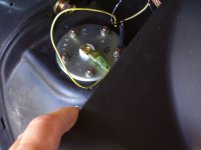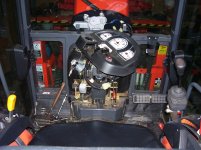Can you post a link to the MM you bought (I'm assuming that you got it from HF). If I can see the front of it I can (as well as others here) can help you understand how to use it. Some mm will automatically scale to the correct level but it sounds like the one you have requires you to pick the scale you need. If so for anything automotive you'll want to use a range that will read 12v (some will have a range of 0-10v while others will have a range of 0-20v) The 10 volt range is too low for most troubleshooting but if you have a 20v range, it will be the one you'll use the most.
Can you post a link to the MM you bought (I'm assuming that you got it from HF).
Digital Multimeter - 7 Function, w/ Backlight
To test for voltage you will want to put the red probe on the contact where the yellow wire connects (sounds like you had it in the correct spot). You'll want to sensor out of the tank and the key on. Measure the voltage on the scale that can read 12 volts first and then the next scale down if you don't get any reading with the float in the lowest position (empty tank). Verify that the fuel gauge is reading empty. Repeat the test with the float in the highest position (full tank). Another useful test would be to measure the resistance (ohms) without the wires connected to the sensor while it's out of the tank in both the lowest and highest positions. This will give you the full range of the level sensor.
A) I set the mm on DCV-20, the sending unit was out of the tank, gauge works correctly, reading was 000. I also set the mm on DCV-2000m and it read 190 with the float at full level, about 1600 1/2 full, and 1 on empty.
One final test I would preform while the sensor is out of the tank would be to measure the resistance (ohms) without any wires connected and have someone slowly move the float from full to empty and then back to full. If while doing this test you see the number drop to zero or read "open" (what the meter reads when reading resistance when the probes aren't touching anything) that means you have bad spot in the sensor and it will not read correctly when the fuel is at that level.
B) I removed the sending unit from the tractor, no wires connected. mm set on ohms-200. empty the reading was 113, 1/2 full the reading was 27, and full it read 4. To get these readings I slowly moved the float up to full then down to empty.
With the sensor in the tank and the wires disconnected read the resistance of the sensor. The number you get should fall within the range of what you read when you measured measured the sensor in both the open and closed positions. If it doesn't then you most likely have a bad sensor. Next connect the wires back up and measure the voltage. It should be within the range you measured when the sensor was out of the tank. If not I would suspect that you may have a damaged wire. If so there are a couple of tests to try.
C) I was a little confused with the above paragraph so here is what I did. I set the mm to ohms-200 and got a reading of 6.0. I also set the mm to ohms-2000 and got a reading of 007.
I also traced every stinky wire to the gauge clusters, pulling, pinching, twisting, etc. to see if things would change, needless to say it did not.


